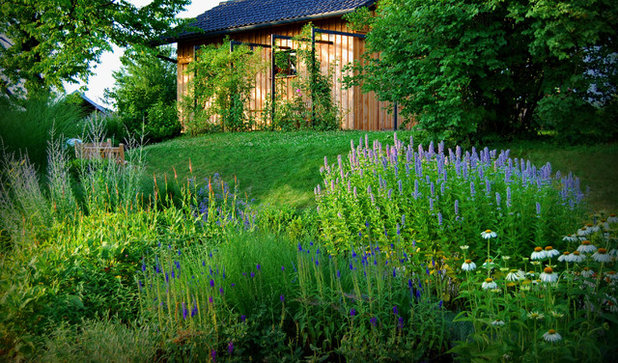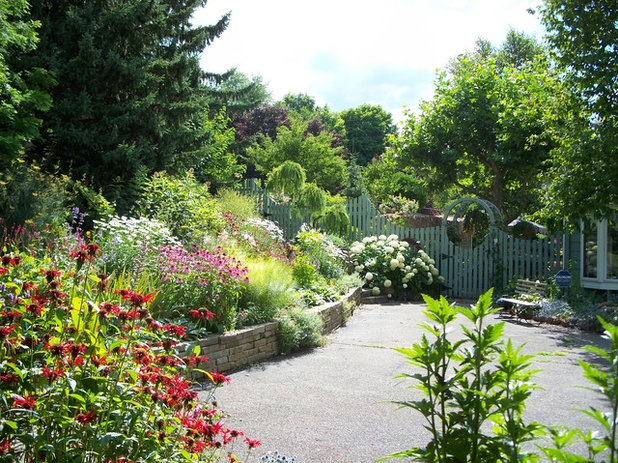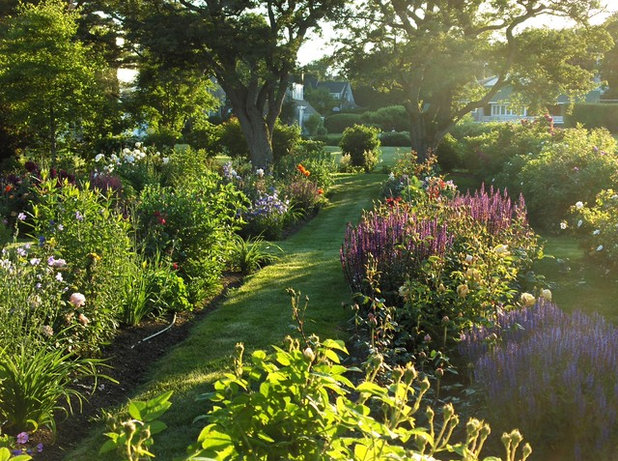It’s finally here. Every morning, before sunrise, the tree canopy ripples in birdcalls. Dew speckles grasses and flowers, each plant cascading in sparkles as the sun crests the fence. A red admiral butterfly dances in seemingly erratic patterns as it follows the spindly trail of a flower’s scent all the way to the source — an early coneflower.
Before the mosquitoes become unbearable and the chigger nymphs stalk our bare feet and legs, it’s time to fully experience the garden we’ve been planning and building this spring, and explore what we might consider improving. Which plant combinations are living up, or down, to our expectations? Is wildlife using the plants and design elements — how and when? Part of being a successful gardener is stepping back to observe the interplay of life we’re fostering.
 1. Take time to observe subtle plant interactions throughout the day.
1. Take time to observe subtle plant interactions throughout the day. Sitting on the deck or patio sipping tea while admiring flowers is one thing; embracing the constant itch to get up and investigate each petal and stem is another. Get out there deep into the plants. Fall down on your hands and knees, or sit still on the soil, and wait to see what comes by. Ants may be farming aphids, trailing up and down the stem of a black-eyed Susan. Small spiders, almost imperceptible, are casting their nets between emerging flower heads of beebalm and coreopsis.
Looking closely at our plants, at how they interact with others and what wildlife is visiting, is important for our minds and spirits. Don’t helicopter; just watch. Maybe the ground cover is losing out to taller plants and should be moved or left to fade. Seeing what flowers compete well with grasses and sedges will help you plan later additions.
If you sit still long enough in this life, you’ll soon realize that everything we thought we had to find will come to us in good time. That’s Garden Wisdom 101.

Healy Design Inc.
2. Notice and record wildlife, and how they’re using the landscape. Take every opportunity to get outside — the plants and the wildlife change every moment, and there are always new displays to find. After a morning walk, take a post-lunch stroll, if just to get some fresh air and exercise those computer-weary eyes. Yes, the sun is much warmer now, but that means the mountain mint is covered in dozens of insect species. Go ahead and reach into the minty clump of white blooms — just be deliberate and confident. I’m a firm believer that all other life senses how we feel.
Note what pollinators are visiting what blooms over the course of the day, and realize that this can guide you to provide even more of what they need. Small butterflies like red admirals will sun themselves on the fence with the last evening light, while larger species like swallowtails will swoop in midday looking for Joe Pye weed and blazing star. Are moths roosting in the shade of the big leaves of prairie dock or wild quinine? What flower seeds are birds eating? Which grasses do birds come to gather for nesting? What more should you add this fall or next spring?

Ann Kearsley Design
3. Follow the day into night, and note how the garden’s double life contributes to its success. Birds come back in a flourish just before sunset. The afternoon heat has subsided, and they are landing in the fountain or birdbath with desperate joy. Maybe you find a toad sheltering in the cool ivory sedge, or, if you’re patient enough, watch a hummingbird at work on a penstemon. As the wavelengths of light coming from the sun change, some flowers will be on notice to close their petals. This is when you should find a secluded corner and follow the day down into night.
Let the slow darkness enshroud you and the garden. Breathe in the deep, moist musk of soil and decaying leaves. Reach out and feel the smooth leaves of baptisia until you find the Braille-like bumps of sulfur butterfly eggs ready to hatch. Watch where the fireflies pulse and hover — how they interact with open areas compared with plant beds. Listen for owls gathering in a nearby tree. Are there places where wildlife need more cover? Could you add a shrub hedgerow or a small tree? Do you need to turn off the landscape lights so that moths can find night flowers?
You helped this space come alive, just as it’s helped you come alive into a new awareness. Your garden is a wildlife refuge for all of us. Tomorrow you’ll have to make a run to the nursery again. Oh, you’ll just have to.





